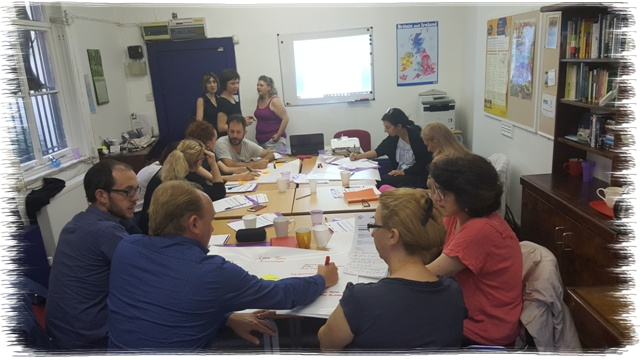Documents Created - Helping you work within Europe
Main menu:
Reports
Reports
Our Conclusions

Minutes of the meeting in London
27th and 28th June 2018, London, the UK
Present:
1. Giuseppina Bomba, CPA di G.Bomba
2. Phillip Carleton, CPA di G.Bomba
3. Antonella Scampoli, "I Cinque Sensi"
4. Daniela Giancristofaro, "I Cinque Sensi"
5. Belen Segarra Murria, CRESOL Association
6. Cristina Moya Salvador, CRESOL Association
7. Sergio Mendoza Cases, CRESOL Association
8. Jose Segarra Murria, CRESOL Association
9. Cristina Mirela Barbaras, Palatul Copiilor Constanta
10. Lacramioara Stratulat, Complex Muzeal National "Moldova"
11. Coralia-Alexandra Costas, Complex Muzeal National "Moldova"
12. Paola Barone, Kairos Europe
13. Tijana Milenkovic Jankovic, Kairos Europe
The host of the second meeting of the WB-TAC project was Kairos Europe Ltd. The meeting started with the activity – creative brain – lateral thinking. This was at the same time an ice breaking activity made of 2 exercises. The first one had the aim to help participants to develop skills by looking at things from various angles. The group was divided into pairs, and one participant was given an object with a basic shape (round, triangular, square). Sitting with their back to each other, one participant described the object without naming it or its apparent use. The task of other participant was to draw a picture based on the description. In the end, the outputs were presented to other participants and the feedback was received.
The second exercise had the aim to find alternative uses to some object. The participants were divided into two groups, and each group was given a set of everyday objects. The group worked with one object at the time and explored different uses for the objects (other than the ordinary use). In the end, they took a photo showing how the objects can be used differently, presented the results and received the feedback.
After the introductory activity, the group has received a presentation about learning through problem-solving, with the following content: the meaning, background, the main characteristics of learning through problem-solving, advantage, disadvantages, examples and steps to designing learning through problem-solving activities.
The third activity aimed to make participants go through a process of problem-solving activity, as well as to develop one. Participants were divided into two teams. The problem they received to solve was to motivate a group of 10 teenagers from different backgrounds to visit some cultural places in London.
In the first phase, the participants needed to prepare one learning through problem-solving activity considering the following:
• Analise which stages for the development of learning through a problem-solving activity they need to follow.
• Research, discuss and prepare the activity.
• Prepare a presentation in which they will explain the activity step by step, what participants will learn, how they will motivate and support them and how they will use available resources.
• Evaluation criteria:
- The phases for development of an activity;
- The group structure and their needs;
- The originality of the idea;
- An educative aspect of the activity;
- Cultural aspect;
- Teamwork.
In the second phase, each team presented their activity and received the feedback from others. The output of both groups was based on the idea to use social media to attract youth to cultural content. On the basis of the group outputs, partners came up with the idea to organise in each partner country a selfie hunt on some cultural spots, with young people/partners target group. Partners will agree about the exact day and the activity rules in the following period.
The last activity on the first day was the location-based game "Cultural London". The task of the partners was to prepare an interesting presentation of visited points that would motivated group of teenagers from the previous activity to visit them, but only when they find the “hidden answer” at the end of the crossword puzzle. The participants needed to find the locations, which are connected with London history and culture, find the answers to write in the crossword, take a photo or video of the place that they can use for the presentation. At the end of the exercise, every group had a task to present the group results in the form of video, photo or oral presentation.
The second day of the meeting started with the reflection of the last activity from the previous day. After that, the representative of the project promoter Ms Giuseppina Bomba informed partners about administrative issues related the project, the problem with Erasmus+ platform, as well as reminded partners about their obligations after the meeting. The next partners meeting is scheduled for 29th and 30th of October 2018 in Romania. As agreed on the first partners meeting, the topic of the meeting will be “Student-based approach”.
The final part of the meeting apart from evaluation and issuing of certificates of attendance were dedicated to the definition of the learning outcomes of the meeting. The partners were divided into two groups with the task to define the importance of learning through problem-solving for:
• The course
• The sustainability
• The effectiveness.